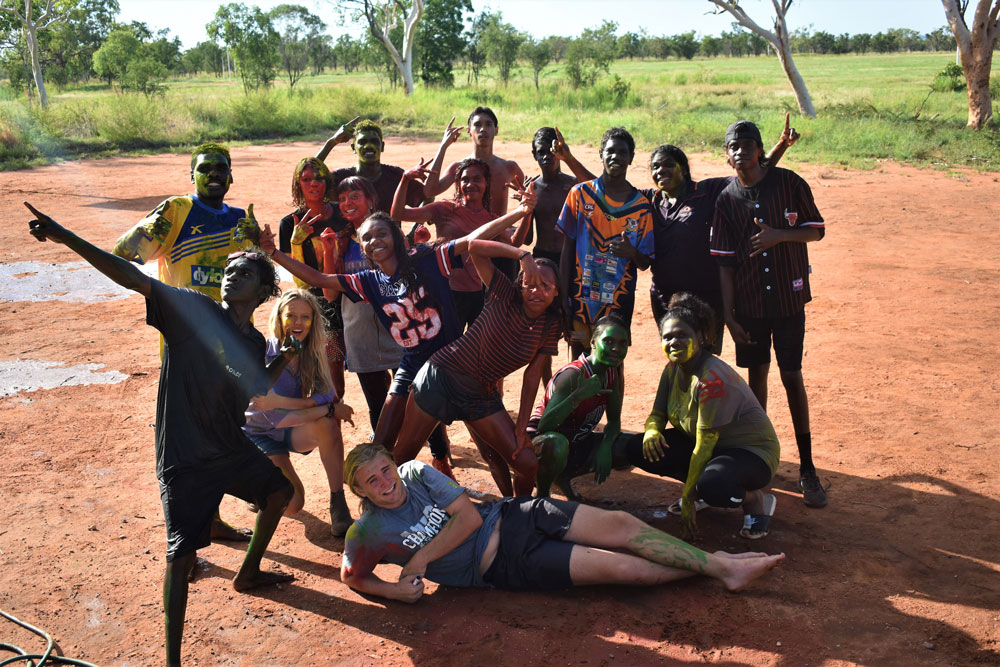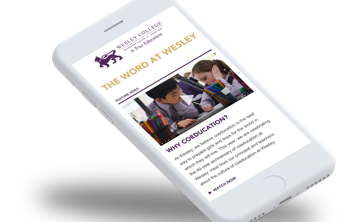Thangani ngarranyi-nhingi (Mother tongue) – learning in Indigenous languages and English

A landmark Indigenous Languages Forum at Yiramalay confirmed that Indigenous languages matter – and two-way learning in Indigenous languages and English is crucial to students’ success.
The Yiramalay/Wesley Studio School hosted the Indigenous Languages Forum onsite at Yiramalay in August – and celebrated the International Year of Indigenous Languages. The two-day forum brought together speakers of 38 languages including Arrernte, Bardi Jawi, Bunuba, Central Arrernte, Dhuwal, Djambarrpuyngu, Dutch, English, French, German, Gooniyandi, Indonesian, Italian, Jaru, Karajarri, Kriol, Manytjilyitjarra, Maori, Murrinhpatha, Pintupi, Ngaanyatjarra, Ngarinyin, Nykinia, Noongar, Pitjantjatjara, Auslan, Turkish, Walmajarri, Wambaya, Wangkatjungka, Warlpiri, Worrorran, Wunumbal, Yankunytjatjarra, Yawuru and Yindjibarndi.
The linguistic diversity of the attendees at the forum underlines the fact that Australia is one of the world’s most linguistically diverse nations.
Languages matter
In her keynote address, Patsy Bedford, Chair of the Kimberley Language Resource Centre, linguist, language teacher and Bunuba woman, said learning one’s mother tongue carries language forward and makes it stronger for future generations. ‘Language is at the core – it is the foundation – of who we are as Indigenous peoples,’ Ms Bedford told the more than 90 attendees at the forum. ‘Language is life, it is everything. When you really hear our language, worlds start to become visible that were hidden before, and the land becomes bigger, deeper and richer.
‘When we talk about a language curriculum today, we are talking about waking up the land and all the knowledge that is within it. I feel very proud that we are on a journey to recognise this in the curriculum of Yiramalay.’
The role of languages in learning
According to the 2018-2019 Yiramalay Languages Position Paper developed by the Yiramalay/Wesley Studio School Languages Working Group, ‘Not knowing English, or knowing forms of English that are stigmatised, is a major aspect of disadvantage and discrimination in contemporary Australia. Yet the country has deepened its multilingualism so that Australia today is widely celebrated as a highly culturally diverse and multilingual country, with hundreds of immigrant languages added to enrich the existing repertoire of Indigenous Australian languages.
‘In effect, languages in Australia have a dual character: they are the expression of an underlying and remarkable cultural diversity, but also an index of inequality, disadvantage and hierarchy.’
According to the position paper, the culture of language learning and teaching at Yiramalay:
- recognises and highlights the important role that languages play in learning throughout the curriculum
- emphasises Aboriginal ways of knowing through appropriate use of language to support learning on country
- supports and respects traditional Indigenous languages, particularly the Bunuba language of the Fitzroy Valley, as well as Kriol and Aboriginal varieties of English
- supports all within the Yiramalay community to acquire functional levels of proficiency in the Bunuba language
- supports all students to achieve the levels of English language competence necessary for proficient communication of their learning and for their productive engagement with others
- respects the linguistic backgrounds and heritages of people from different language groups
- sees every teacher as a teacher of language, and
- appreciates the diverse cultural and linguistic backgrounds present at Yiramalay.
Protecting and promoting the languages of all people
Also speaking at the forum, fellow keynote, Dr Joseph Lo Bianco, Professor of Language and Literacy Education at the Melbourne Graduate School of Education at the University of Melbourne, said that with 97 per cent of the world’s languages now spoken by only two per cent of the world’s people, language loss is a global issue. One of the key strategies to protect and cultivate endangered languages is to use children’s mother tongue as the language for schooling.
The Use of Vernacular Languages in Education, published by UNESCO in 1953 noted that the best medium for teaching is the mother tongue of the student. In practice, Dr Lo Bianco said, education should take a multilingual approach using children’s mother tongue and an international language such as English.
According to Dr Lo Bianco, it helps to think about language not only in terms of basic communication ability but also cognitive language ability for academic purposes. ‘Children and young people need a “learning language,” a strong code, to become literate and learn new concepts,’ Dr Lo Bianco said. ‘All children should learn initially in their strongest language, then orally in the second language, then in writing in both, then orally in a third language and then in writing in all three.’
Practical ideas
Kate Reitzenstein, Languages Consultant at the Association of Independent Schools of Western Australia, explored a range of practices with forum attendees to turn that strategy into everyday practice. ‘A great first step to start a traditional language program is to put it on the timetable. Formalise it. This will give status to the language as a subject,’ Ms Reitzenstein said. ‘Find a community member who speaks some language and is willing to teach, or willing to learn how to teach. Support them with the training they need to teach and to build-up confidence.
‘Language learning also has to happen outside the classroom. Integrate it as much as possible in on-country learning. Invite Elders on-country with the students to speak in language and teach in context. Take photographs and recordings because this material provides the stimulus for learning in the classroom.
‘Use traditional language to name things around the schools such as buildings, programs or classes. One Walmatjarri teacher recently said to me that she wished that her school would refer to a class with a Walmajarri name, rather than the name of the classroom teacher. Teachers come and go, but the community and language always stay.
‘Use traditional language, in signage, on your website, for your voicemail message, with traditional language first. Identify the minimum you expect everyone who works and learns on this country to be able to say in traditional language: from ‘Good morning’ to ‘What’s up?’ Teach this and set an example.
‘And don’t underestimate the power of songs and music in language learning. Language learning is about mastering what we call ‘meaningful chunks of text’ – the building block for language acquisition – and songs can play an important role in the learning, memorising and retaining of such expressions.’
In a workshop with Ms Reitzenstein, Yiramalay students at the forum identified the practices that helped and hindered their language learning. What helped? Language classes at primary school and having family members teaching and working in their school. What hindered? Speaking English most of the time, the absence of a traditional language program in high school and the passing of older language users. So what’s needed? More traditional language taught at school by more language teachers, and more traditional language in and around the school.
And the key takeaway? ‘To successfully revitalise a traditional language, it requires a dozen or so speakers to learn the language and use it by communicating with each other on a daily basis,’ Ms Reitzenstein said.
In the words of Patsy Bedford, Indigenous languages are sleeping, but programs like Yiramalay are helping to wake them up. ‘Here at Yiramalay we are at a stage where Indigenous and non‐Indigenous peoples are prepared to change the curriculum so English alongside Bunuba are seen as equally important,’ Ms Bedford said.
